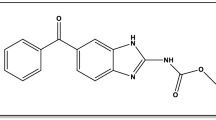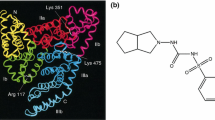Abstract
Among the biological parameters of chemotherapeutics, serum albumin binding is a critical factor in determining drug distribution and bioavailability. In this study, the binding properties as well as the interaction of ampicillin and streptomycin at their binding sites of bovine serum albumin (BSA) were investigated. The binding constant varied from 3.2 × 103 M−1 at 298 K to 37.5 × 103 M−1 at 313 K for ampicillin, and from 10.7 × 103 M−1 at 298 K to 3.5 × 103 M−1 at 313 K for streptomycin. By increasing the temperature, from 298 to 313 K, the binding affinity decreased by about 11-fold for ampicillin. Conversely, streptomycin showed stronger binding at higher temperature, which is decreased by threefold at 298 K. Interestingly, the affinity of ampicillin with the free BSA was ~4-fold higher than the binding with BSA/streptomycin complex. In contrast, the affinity of streptomycin with the free BSA was ~6-fold lower than the binding with BSA/ampicillin complex. Mutual binding experiments indicate that ampicillin and streptomycin are sharing both of common and different binding sites on BSA. Dissection of the forces of interactions indicated that rigid-body binding was the mode of binding of ampicillin and streptomycin with BSA with minor degree of conformational changes. Both of ampicillin and streptomycin can bind with free BSA. Furthermore, the binding of ampicillin with BSA improves the binding of streptomycin, while the binding of streptomycin with BSA adversely affect the binding of ampicillin.





Similar content being viewed by others
References
Joseph KS, Anguizola J, Hage DS. Binding of tolbutamide to glycated human serum albumin. J Pharm Biomed Anal. 2011;54(2):426–32. doi:10.1016/j.jpba.2010.09.003.
Chandrasekaran A, Shen L, Lockhead S, Oganesian A, Wang J, Scatina J. Reversible covalent binding of neratinib to human serum albumin in vitro. Drug Metab Lett. 2010;4(4):220–7. doi:BSP/DML/E-Pub/00050.
Wang J, Li-Chan XX, Atherton J, Deng L, Espina R, Yu L, et al. Characterization of HKI-272 covalent binding to human serum albumin. Drug Metab Dispos. 2010;38(7):1083–93. doi:10.1124/dmd.110.032292.
Kandeel M, Kitade Y. Analysis of the molecular interactions and complexation of chloroquine with bovine serum albumin. Drug Metab Drug Interact. 2012;27(1):41–6. doi:10.1515/DMDI.2011.030.
Kandeel M, Nabih M, Kitade Y. Macromolecular interactions of spectinomycin with Bovine serum albumin. J Therm Anal Calorim. 1–5. doi:10.1007/s10973-012-2265-y.
Otagiri M. A molecular functional study on the interactions of drugs with plasma proteins. Drug Metab Pharmacokinet. 2005;20(5):309–23. doi:JST.JSTAGE/dmpk/20.309.
Cheng Z. Interaction of ergosterol with bovine serum albumin and human serum albumin by spectroscopic analysis. Mol Biol Rep. 2012;. doi:10.1007/s11033-012-1814-6.
Sun Y, Su B, Xu Q, Liu R. Insights into the binding of 2-aminobenzothiazole with human serum albumin (HSA): spectroscopic investigation and molecular modeling studies. Appl Spectrosc. 2012;66(7):791–7. doi:10.1366/11-06524.
Sengupta A, Sasikala WD, Mukherjee A, Hazra P. Comparative study of flavins binding with human serum albumin: a fluorometric, thermodynamic, and molecular dynamics approach. ChemPhysChem. 2012;13(8):2142–53. doi:10.1002/cphc.201200044.
Sun Y, Ji Z, Liang X, Li G, Yang S, Wei S, et al. Studies on the binding of rhaponticin with human serum albumin by molecular spectroscopy, modeling and equilibrium dialysis. Spectrochim Acta A. 2012;87:171–8. doi:10.1016/j.saa.2011.11.033.
Kandeel M, Kitade Y. Binding dynamics and energetic insight into the molecular forces driving nucleotide binding by guanylate kinase. J Mol Recognit. 2010;. doi:10.1002/jmr.1074.
Kandeel M, Kitade Y. Substrate specificity and nucleotides binding properties of NM23H2/nucleoside diphosphate kinase homolog from Plasmodium falciparum. J Bioenerg Biomembr. 2010;42(5):361–9. doi:10.1007/s10863-010-9304-9.
Kandeel M, Ando T, Kitamura Y, Abdel-Aziz M, Kitade Y. Mutational, inhibitory and microcalorimetric analyses of Plasmodium falciparum TMP kinase. Implications for drug discovery. Parasitology. 2009;136(1):11–25. doi:10.1017/S0031182008005301.
Wszelaka-Rylik M, Gierycz P. Isothermal titration calorimetry (ITC) study of natural cyclodextrins inclusion complexes with drugs. J Therm Anal Calorim. 1–7. doi:10.1007/s10973-012-2251-4.
Al-Anber Z. Thermodynamic studies of interaction between cetylpyridinium bromide and lysozyme by means of calorimetric titrations. J Thermal Anal Calorim. 1–8. doi:10.1007/s10973-011-2146-9.
Baker BM, Murphy KP. Prediction of binding energetics from structure using empirical parameterization. Methods Enzymol. 1998;295:294–315.
Makhatadze GI, Privalov PL. Energetics of protein structure. Adv Protein Chem. 1995;47:307–425.
Jelesarov I, Bosshard HR. Isothermal titration calorimetry and differential scanning calorimetry as complementary tools to investigate the energetics of biomolecular recognition. J Mol Recognit. 1999;12(1):3–18. doi:10.1002/(SICI)1099-1352(199901/02)12:1<3:AID-JMR441>3.0.CO;2-6.
Quesada-Soriano I, Musso-Buendia JA, Tellez-Sanz R, Ruiz-Perez LM, Baron C, Gonzalez-Pacanowska D, et al. Plasmodium falciparum dUTPase: studies on protein stability and binding of deoxyuridine derivatives. Biochim Biophys Acta. 2007;1774(7):936–45. doi:10.1016/j.bbapap.2007.04.013. S1570-9639(07)00100-8 [pii].
Islam M, Kumar GS. Small molecule-RNA interaction: spectroscopic and calorimetric studies on the binding by the cytotoxic protoberberine alkaloid coralyne to single stranded polyribonucleotides. Biochim Biophys Acta. 2009;1790(8):829–39. doi:10.1016/j.bbagen.2009.05.015.
Vamvaca K, Jelesarov I, Hilvert D. Kinetics and thermodynamics of ligand binding to a molten globular enzyme and its native counterpart. J Mol Biol. 2008;382(4):971–7. doi:10.1016/j.jmb.2008.07.049.
Boniface JJ, Reich Z, Lyons DS, Davis MM. Thermodynamics of T cell receptor binding to peptide-MHC: evidence for a general mechanism of molecular scanning. Proc Natl Acad Sci USA. 1999;96(20):11446–51.
Author information
Authors and Affiliations
Corresponding authors
Rights and permissions
About this article
Cite this article
Kandeel, M., Nakashima, R., Kitamura, Y. et al. Thermodynamics and molecular bases of the interaction of ampicillin and streptomycin at their binding sites of bovine serum albumin. J Therm Anal Calorim 112, 945–952 (2013). https://doi.org/10.1007/s10973-012-2586-x
Received:
Accepted:
Published:
Issue Date:
DOI: https://doi.org/10.1007/s10973-012-2586-x




